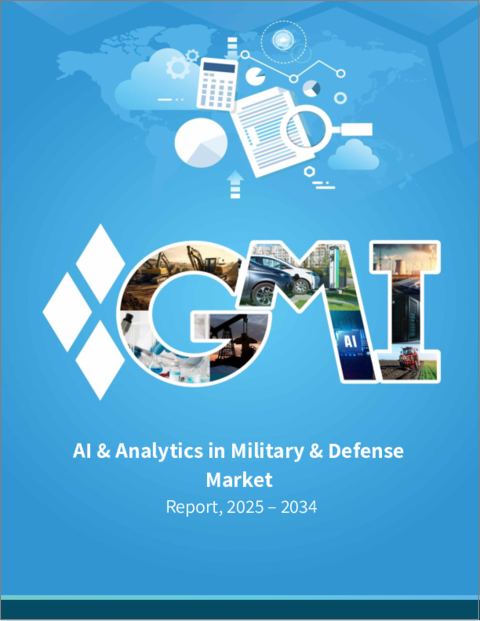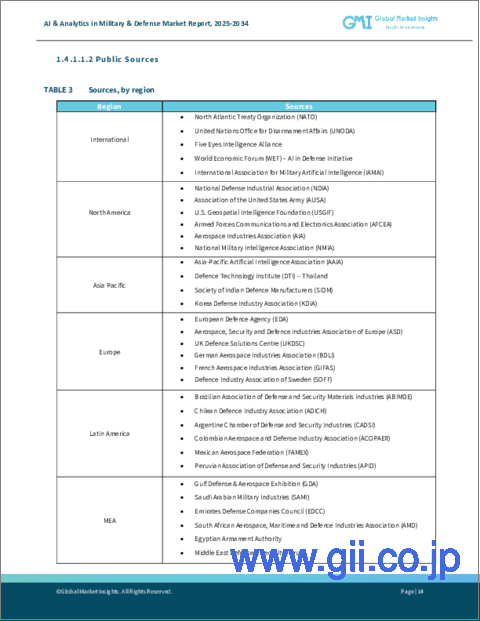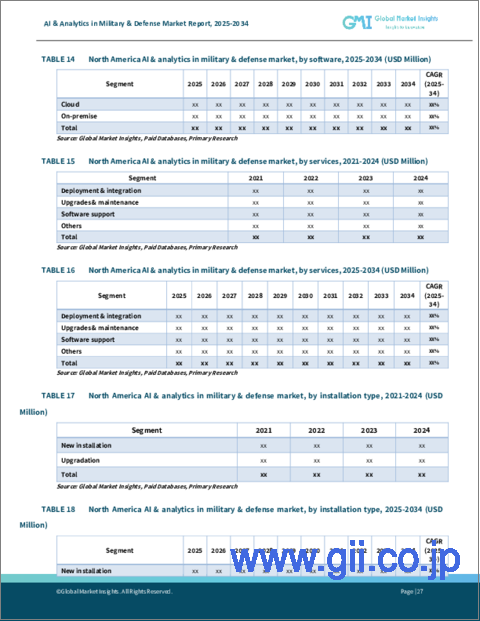|
|
市場調査レポート
商品コード
1638832
軍事・防衛分野におけるAIおよびアナリティクス市場の機会、成長促進要因、産業動向分析、2025年~2034年の予測AI and Analytics in Military and Defense Market Opportunity, Growth Drivers, Industry Trend Analysis, and Forecast 2025 to 2034 |
||||||
カスタマイズ可能
|
|||||||
| 軍事・防衛分野におけるAIおよびアナリティクス市場の機会、成長促進要因、産業動向分析、2025年~2034年の予測 |
|
出版日: 2024年11月13日
発行: Global Market Insights Inc.
ページ情報: 英文 210 Pages
納期: 2~3営業日
|
- 全表示
- 概要
- 目次
軍事・防衛分野におけるAIおよびアナリティクスの世界市場は、2024年に104億米ドルに達し、2025年から2034年にかけてCAGR 13.4%で成長すると予測されています。
この拡大は、AI駆動型技術の採用が増加し、効率性、意思決定、作戦能力を強化することで現代の軍事作戦を変革することが原動力となっています。
無人車両や海軍プラットフォームなどの自律システムは、防衛戦略の中心になりつつあります。高度なAIアルゴリズムを搭載したこれらのシステムは、監視や偵察から精密な作戦まで幅広いタスクを実行し、リスクの高いシナリオにおける人間の関与を大幅に削減します。また、単独または共同での運用が可能なため、耐久性、適応性、任務遂行において優位性を発揮します。世界中の軍隊が情報収集、ロジスティクス、戦場支援を優先する中、AIの開発と自律型プラットフォームへの統合は引き続き重要な焦点となっています。
市場は、ハードウェア、ソフトウェア、サービスの提供によって区分されます。このうち、ソフトウェア分野は2025~2034年にCAGR 14%で成長すると予測されています。AIと分析ソフトウェアは、予知保全、リアルタイムの状況認識、最適化された意思決定を通じて軍事能力を強化します。これらのプラットフォームは膨大な量のデータを処理し、脅威検知、インテリジェンス分析、サイバーセキュリティなどの運用効率を向上させる実用的な洞察を提供します。さらに、自律システムの進歩は、ミッションクリティカルなタスクのための無人車両、ドローン、ロボット技術をサポートするために、AIを搭載したソフトウェアに大きく依存しています。
| 市場範囲 | |
|---|---|
| 開始年 | 2024 |
| 予測年 | 2025-2034 |
| 開始金額 | 104億米ドル |
| 予測金額 | 358億米ドル |
| CAGR | 13.4% |
用途別では、戦争プラットフォーム、ロジスティクス、監視、コマンドシステム、シミュレーション、脅威検知、情報処理など、さまざまな分野をカバーしています。情報処理分野は、2024年の売上高が22億米ドルで市場をリードしています。エッジコンピューティングのような技術革新は、センサーや無人プラットフォームなどの起点に処理を分散させることで、データ分析に革命をもたらしています。この技術によってリアルタイムの意思決定が可能になり、遅れが不利になる戦闘シナリオでの即時対応の必要性に対応できます。
地域別では、北米が2024年の市場で37.7%のシェアを占めました。無人航空機や地上車両を含む軍事システムへのAIの統合が、同地域の主要な推進力となっています。これらの技術は自律性を強化し、システムが迅速な意思決定を行い、複雑な作戦環境に適応できるようにします。このような進歩は、情報、監視、偵察において特に価値が高く、人間の介入を最小限に抑えながら、広大な地域での効率的なデータ収集を保証します。
防衛分野におけるAIとアナリティクスへの依存の高まりは、現代の戦争と作戦戦略の形成におけるこの分野の極めて重要な役割を浮き彫りにし、世界の軍事情勢におけるその重要性を強調しています。
目次
第1章 調査手法と調査範囲
第2章 エグゼクティブサマリー
第3章 業界洞察
- エコシステム分析
- バリューチェーンに影響を与える要因
- 利益率分析
- 破壊
- 将来の展望
- メーカー
- 流通業者
- サプライヤーの状況
- 利益率分析
- 主要ニュースと取り組み
- 規制状況
- 影響要因
- 促進要因
- 戦術無人航空機システム(UAS)の進歩
- AIを活用したリアルタイムデータ分析の利用増加
- AI駆動型自律システムの統合の増加
- AIで強化されたトレーニングとシミュレーション技術の採用
- 予知保全とロジスティクスの進歩
- 業界の潜在的リスク&課題
- データ・セキュリティとプライバシーに関する懸念
- レガシーシステムとの統合と相互運用性
- 促進要因
- 成長可能性分析
- ポーター分析
- PESTEL分析
第4章 競合情勢
- イントロダクション
- 企業シェア分析
- 競合のポジショニング・マトリックス
- 戦略展望マトリックス
第5章 市場推計・予測:提供別、2021年~2034年
- 主要動向
- ハードウェア
- ソフトウェア
- クラウド
- オンプレミス
- サービス
- 導入と統合
- アップグレードとメンテナンス
- ソフトウェアサポート
- その他
第6章 市場推計・予測:導入タイプ別、2021年~2034年
- 主要動向
- 新規導入
- アップグレード
第7章 市場推計・予測:技術別、2021年~2034年
- 主要動向
- 機械学習
- 自然言語処理
- コンテキスト対応コンピューティング
- コンピュータビジョン
- インテリジェント・バーチャル・エージェント(Iva)/バーチャル・エージェント
- その他
第8章 市場推計・予測:用途別、2021年~2034年
- 主要動向
- 戦争プラットフォーム
- サイバーセキュリティ
- 物流・輸送
- 監視・状況認識
- コマンド&コントロール
- 戦場ヘルスケア
- シミュレーションとトレーニング
- 脅威検知
- 情報処理
- その他
第9章 市場推計・予測:プラットフォーム別、2021年~2034年
- 主要動向
- 航空機
- 戦闘機
- 特殊任務機
- ヘリコプター
- 無人航空機(UAV)
- 陸上
- 軍用戦闘車両(MFV)
- 無人地上車両(UGV)
- 兵器システム
- 本部・司令部
- 海軍
- 船舶
- 潜水艦
- 無人海上車両(UMV)
- 宇宙
- キューブサット
- 人工衛星
第10章 市場推計・予測:地域別、2021年~2034年
- 主要動向
- 北米
- 米国
- カナダ
- 欧州
- 英国
- ドイツ
- フランス
- イタリア
- スペイン
- ロシア
- アジア太平洋
- 中国
- インド
- 日本
- 韓国
- オーストラリア
- ラテンアメリカ
- ブラジル
- メキシコ
- 中東・アフリカ
- 南アフリカ
- サウジアラビア
- アラブ首長国連邦
第11章 企業プロファイル
- Avathon
- BAE Systems
- CACI International
- Charles River Analytics
- IBM
- L3Harris Technologies
- Leonardo
- Lockheed Martin
- Northrop Grumman
- Nvidia
- Rafael Advanced Defense Systems
- Raytheon Technologies
- Saab
- Safran
- Shield AI
- Thales
The Global AI And Analytics In Military And Defense Market reached USD 10.4 billion in 2024 and is projected to grow at a CAGR of 13.4% from 2025 to 2034. This expansion is driven by the increasing adoption of AI-driven technologies, transforming modern military operations by enhancing efficiency, decision-making, and operational capabilities.
Autonomous systems, such as unmanned vehicles and naval platforms, are becoming central to defense strategies. These systems, powered by advanced AI algorithms, perform tasks ranging from surveillance and reconnaissance to precision operations, significantly reducing human involvement in high-risk scenarios. Their ability to operate independently or collaboratively offers advantages in endurance, adaptability, and mission execution. As militaries worldwide prioritize intelligence gathering, logistics, and battlefield support, the development and integration of AI into autonomous platforms remain a critical focus.
The market is segmented by offering hardware, software, and services. Among these, the software segment is anticipated to grow at a CAGR of 14% during 2025-2034. AI and analytics software enhance military capabilities through predictive maintenance, real-time situational awareness, and optimized decision-making. These platforms process vast amounts of data, delivering actionable insights that improve efficiency in operations such as threat detection, intelligence analysis, and cybersecurity. Additionally, advancements in autonomous systems rely heavily on AI-powered software to support unmanned vehicles, drones, and robotic technologies for mission-critical tasks.
| Market Scope | |
|---|---|
| Start Year | 2024 |
| Forecast Year | 2025-2034 |
| Start Value | $10.4 Billion |
| Forecast Value | $35.8 Billion |
| CAGR | 13.4% |
In terms of application, the market covers various areas, including warfare platforms, logistics, surveillance, command systems, simulation, threat detection, and information processing. The information processing segment led the market with USD 2.2 billion in revenue in 2024. Innovations like edge computing are revolutionizing data analysis by decentralizing processing to the point of origin, such as sensors or unmanned platforms. This technology enables real-time decision-making, addressing the need for immediate responses during combat scenarios where delays can be detrimental.
Regionally, North America dominated the market in 2024, accounting for a 37.7% share. The integration of AI into military systems, including unmanned aerial and ground vehicles, is a major driver in the region. These technologies enhance autonomy, allowing systems to make rapid decisions and adapt to complex operational environments. Such advancements are particularly valuable in intelligence, surveillance, and reconnaissance, ensuring efficient data collection over expansive areas while minimizing human intervention.
This growing reliance on AI and analytics in defense highlights the sector's pivotal role in shaping modern warfare and operational strategies, underscoring its importance in the global military landscape.
Table of Contents
Chapter 1 Methodology & Scope
- 1.1 Market scope & definitions
- 1.2 Base estimates & calculations
- 1.3 Forecast calculations
- 1.4 Data sources
- 1.4.1 Primary
- 1.4.2 Secondary
- 1.4.2.1 Paid sources
- 1.4.2.2 Public sources
Chapter 2 Executive Summary
- 2.1 Industry synopsis, 2021-2034
Chapter 3 Industry Insights
- 3.1 Industry ecosystem analysis
- 3.1.1 Factor affecting the value chain
- 3.1.2 Profit margin analysis
- 3.1.3 Disruptions
- 3.1.4 Future outlook
- 3.1.5 Manufacturers
- 3.1.6 Distributors
- 3.2 Supplier landscape
- 3.3 Profit margin analysis
- 3.4 Key news & initiatives
- 3.5 Regulatory landscape
- 3.6 Impact forces
- 3.6.1 Growth drivers
- 3.6.1.1 Advancements in tactical unmanned aircraft systems (UAS)
- 3.6.1.2 Increasing use of AI-powered real-time data analytics
- 3.6.1.3 Rising integration of AI-driven autonomous systems
- 3.6.1.4 Adoption of AI-enhanced training and simulation technologies
- 3.6.1.5 Advancements in predictive maintenance and logistics
- 3.6.2 Industry pitfalls & challenges
- 3.6.2.1 Data security and privacy concerns
- 3.6.2.2 Integration and interoperability with legacy systems
- 3.6.1 Growth drivers
- 3.7 Growth potential analysis
- 3.8 Porter's analysis
- 3.9 PESTEL analysis
Chapter 4 Competitive Landscape, 2024
- 4.1 Introduction
- 4.2 Company market share analysis
- 4.3 Competitive positioning matrix
- 4.4 Strategic outlook matrix
Chapter 5 Market Estimates & Forecast, By Offering, 2021-2034 (USD Million)
- 5.1 Key trends
- 5.2 Hardware
- 5.3 Software
- 5.3.1 Cloud
- 5.3.2 On-premise
- 5.4 Services
- 5.4.1 Deployment & integration
- 5.4.2 Upgrades & maintenance
- 5.4.3 Software support
- 5.4.4 Others
Chapter 6 Market Estimates & Forecast, By Installation Type, 2021-2034 (USD Million)
- 6.1 Key trends
- 6.2 New Installation
- 6.3 Upgradation
Chapter 7 Market Estimates & Forecast, By Technology, 2021-2034 (USD Million)
- 7.1 Key trends
- 7.2 Machine learning
- 7.3 Natural language processing
- 7.4 Context-aware computing
- 7.5 Computer vision
- 7.6 Intelligent virtual agent (Iva) /virtual agents
- 7.7 Others
Chapter 8 Market Estimates & Forecast, By Application, 2021-2034 (USD Million)
- 8.1 Key trends
- 8.2 Warfare platforms
- 8.3 Cybersecurity
- 8.4 Logistics & transportation
- 8.5 Surveillance & situational awareness
- 8.6 Command & control
- 8.7 Battlefield healthcare
- 8.8 Simulation & training
- 8.9 Threat detection
- 8.10 Information processing
- 8.11 Others
Chapter 9 Market Estimates & Forecast, By Platform, 2021-2034 (USD Million)
- 9.1 Key trends
- 9.2 Airborne
- 9.2.1 Fighter aircraft
- 9.2.2 Special mission aircraft
- 9.2.3 Helicopters
- 9.2.4 Unmanned aerial vehicles (UAV)
- 9.3 Land
- 9.3.1 Military fighting vehicles (MFV)
- 9.3.2 Unmanned ground vehicles (UGV)
- 9.3.3 Weapons systems
- 9.3.4 Headquarter & command centers
- 9.4 Naval
- 9.4.1 Ships
- 9.4.2 Submarines
- 9.4.3 Unmanned marine vehicles (UMVs)
- 9.5 Space
- 9.5.1 CubeSats
- 9.5.2 Satellites
Chapter 10 Market Estimates & Forecast, By Region, 2021-2034 (USD Million)
- 10.1 Key trends
- 10.2 North America
- 10.2.1 U.S.
- 10.2.2 Canada
- 10.3 Europe
- 10.3.1 UK
- 10.3.2 Germany
- 10.3.3 France
- 10.3.4 Italy
- 10.3.5 Spain
- 10.3.6 Russia
- 10.4 Asia Pacific
- 10.4.1 China
- 10.4.2 India
- 10.4.3 Japan
- 10.4.4 South Korea
- 10.4.5 Australia
- 10.5 Latin America
- 10.5.1 Brazil
- 10.5.2 Mexico
- 10.6 MEA
- 10.6.1 South Africa
- 10.6.2 Saudi Arabia
- 10.6.3 UAE
Chapter 11 Company Profiles
- 11.1 Avathon
- 11.2 BAE Systems
- 11.3 CACI International
- 11.4 Charles River Analytics
- 11.5 IBM
- 11.6 L3Harris Technologies
- 11.7 Leonardo
- 11.8 Lockheed Martin
- 11.9 Northrop Grumman
- 11.10 Nvidia
- 11.11 Rafael Advanced Defense Systems
- 11.12 Raytheon Technologies
- 11.13 Saab
- 11.14 Safran
- 11.15 Shield AI
- 11.16 Thales





